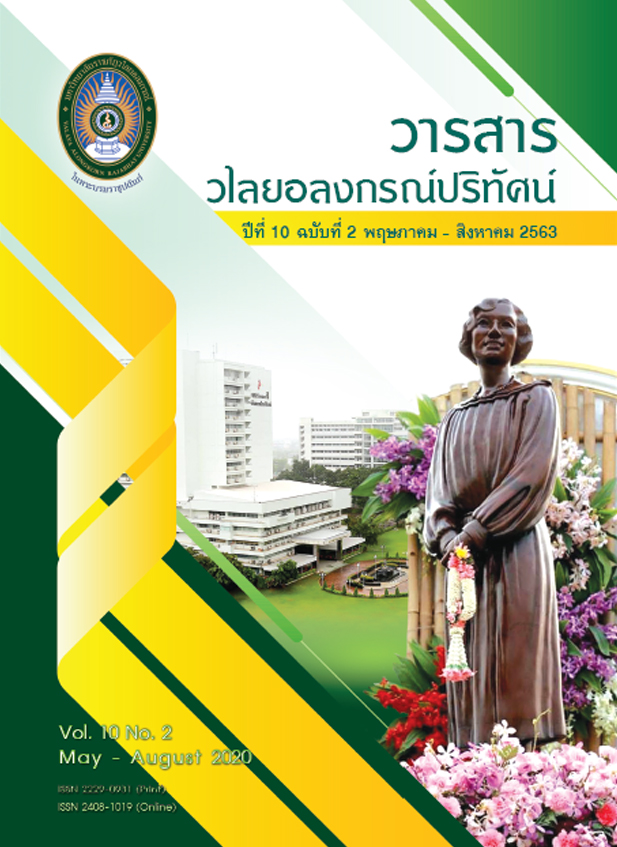การวิเคราะห์องค์ประกอบของมโนทัศน์ที่คลาดเคลื่อนทางพีชคณิต สำหรับนักเรียนระดับมัธยมศึกษาตอนต้น
คำสำคัญ:
การวิเคราะห์องค์ประกอบ, มโนทัศน์ที่คลาดเคลื่อนทางพีชคณิตบทคัดย่อ
การวิจัยครั้งนี้มีวัตถุประสงค์เพื่อ 1) วิเคราะห์องค์ประกอบของมโนทัศน์ที่คลาดเคลื่อนทางพีชคณิต สำหรับนักเรียนระดับมัธยมศึกษาตอนต้น 2) ตรวจสอบความสอดคล้องกลมกลืนของโมเดลองค์ประกอบของมโนทัศน์ที่คลาดเคลื่อนทางพีชคณิต สำหรับนักเรียนระดับมัธยมศึกษาตอนต้นกับข้อมูลเชิงประจักษ์ ประชากรเป็นนักเรียนระดับมัธยมศึกษาตอนต้น สังกัดองค์กรปกครองส่วนท้องถิ่น จังหวัดสระบุรี จำนวน 2,140 คน กลุ่มตัวอย่างเป็นนักเรียนระดับมัธยมศึกษาตอนต้น จำนวน 400 คน ได้มาจากการสุ่มแบบหลายขั้นตอน เครื่องมือที่ใช้ในการวิจัย คือ แบบทดสอบการวินิจฉัยมโนทัศน์ที่คลาดเคลื่อนทางพีชคณิตสำหรับนักเรียนระดับชั้นมัธยมศึกษาตอนต้น แบ่งเป็น 3 องค์ประกอบ ได้แก่ องค์ประกอบที่ 1 ด้านภาษา และสัญลักษณ์ องค์ประกอบที่ 2 ด้านการใช้บทนิยาม ทฤษฎีบท และสมบัติ และองค์ประกอบที่ 3 ด้านขั้นตอนการดำเนินการ และการสรุปผล มีค่าดัชนีความสอดคล้อง 0.86-1.00 ค่าความยากง่าย 0.40-0.59 ค่าอำนาจจำแนก 0.56-0.84 และค่าความเชื่อมั่นของแบบทดสอบเท่ากับ 0.83 วิเคราะห์ข้อมูลโดยคำนวณค่าเฉลี่ย ส่วนเบี่ยงเบนมาตรฐาน ค่าสัมประสิทธิ์สหสัมพันธ์ของเพียร์สัน และการวิเคราะห์องค์ประกอบเชิงยืนยันโดยโปรแกรมสำเร็จรูปทางสถิติลิสเรล
ผลการวิจัยพบว่า 1) องค์ประกอบของมโนทัศน์ที่คลาดเคลื่อนทางพีชคณิต สำหรับนักเรียนระดับมัธยมศึกษาตอนต้นประกอบด้วย 3 องค์ประกอบมีค่าน้ำหนักองค์ประกอบ 0.51 - 0.71 เรียงค่าน้ำหนักองค์ประกอบจากมากไปน้อยได้ดังนี้คือ องค์ประกอบที่ 1 ด้านภาษา และสัญลักษณ์ องค์ประกอบที่ 2 ด้านการใช้บทนิยาม ทฤษฎีบท และสมบัติ และองค์ประกอบที่ 3ด้านขั้นตอนการดำเนินการ และการสรุปผล มีค่าน้ำหนักองค์ประกอบเท่ากับ 0.71, 0.63, 0.51 ตามลำดับ 2) ผลการตรวจสอบความสอดคล้องกลมกลืนของโมเดลองค์ประกอบมโนทัศน์ที่คลาดเคลื่อนทางพีชคณิต สำหรับนักเรียนระดับมัธยมศึกษาตอนต้นที่พัฒนาขึ้นมีความสอดคล้องกลมกลืนกับข้อมูลเชิงประจักษ์โดยมีค่า Chi-Square เท่ากับ 33.41 ค่าองศาอิสระ (df) เท่ากับ 23 ค่าระดับนัยสำคัญ (P value) เท่ากับ 0.074 ค่าดัชนีวัดระดับความกลมกลืน (GFI) เท่ากับ 0.98 ค่าดัชนีวัดระดับความกลมกลืนปรับแก้แล้ว (AGFI) เท่ากับ 0.96 ค่าดัชนีวัดระดับความสอดคล้องกลมกลืนเปรียบเทียบ (CFI) เท่ากับ 1.00 ค่าดัชนีรากกำลังสองเฉลี่ยของความคลาดเคลื่อนในการประมาณค่า (RMSEA) เท่ากับ 0.034 และค่าดัชนีค่ารากของค่าเฉลี่ยกำลังสองเฉลี่ยของเศษเหลือในรูปคะแนนมาตรฐาน (SRMR) เท่ากับ 0.02
เอกสารอ้างอิง
กระทรวงศึกษาธิการ. (2560). คู่มือการใช้หลักสูตร กลุ่มสาระการเรียนรู้คณิตศาสตร์ (ฉบับปรับปรุง พ.ศ. 2560) ตามหลักสูตรแกนกลางการศึกษาขั้นพื้นฐาน พุทธศักราช 2551 ระดับมัธยมศึกษาตอนต้น. กรุงเทพฯ: โรงพิมพ์ชุมนุมสหกรณ์การเกษตรแห่งประเทศไทย.
ฉวีวรรณ รัตนประเสริฐ. (2561). พีชคณิต: โครงการตำราวิทยาศาสตร์และคณิตศาสตร์มูลนิธิ สอวน. (พิมพ์ครั้งที่ 6). กรุงเทพฯ: ด่านสุทธาการพิมพ์.
นงลักษณ์ วิรัชชัย. (2557). มโนทัศน์ที่คลาดเคลื่อนในการวิจัยการศึกษา. นนทบุรี: สถาบันวิจัยและพัฒนามหาวิทยาลัยสุโขทัยธรรมาธิราช.
นวพล นนทภา. (2559). การพัฒนากลวิธีในการแก้ไขมโนทัศน์คลาดเคลื่อนทางระบบจำนวนสำหรับนักศึกษาระดับปริญญาตรี. มหาสารคาม: มหาวิทยาลัยราชภัฏมหาสารคาม.
วัชรา เล่าเรียนดี ปรณัฐ กิจรุ่งเรือง และอรพิณ ศิริสัมพันธ์. (2560). กลยุทธ์การจัดการเรียนรู้เชิงรุกเพื่อพัฒนาการคิดและยกระดับคุณภาพการศึกษา สำหรับศตวรรษที่ 21. (พิมพ์ครั้งที่ 12). นครปฐม: เพชรเกษมพริ้นติ้ง กรุ๊ป.
วิไล ทองแผ่. (2547). หลักการวัดและประเมินผลการศึกษา. ลพบุรี: คณะครุศาสตร์ มหาวิทยาลัยราชภัฎเทพสตรี.
เวชฤทธิ์ อังกนะภัทรขจร. (2557). การศึกษามโนทัศน์ทางคณิตศาสตร์ของนิสิตวิชาเอกคณิตศาสตร์. ชลบุรี: ภาควิชาการจัดการเรียนรู้ คณะศึกษาศาสตร์ มหาวิทยาลัยบูรพา.
ศักดา กิ่งโก้. (2560). การพัฒนาแบบทดสอบวินิจฉัยแบบสี่ชั้นและตัวแบบกิจกรรมการปรับลดมโนทัศน์ที่คลาดเคลื่อนในวิชาแคลคูลัส 1 ของนักศึกษาระดับประกาศนียบัตรวิชาชีพชั้นสูง. วิทยานิพนธ์ปรัชญาดุษฎีบัณฑิต สาขาวิชาวิจัยวัดผลและสถิติการศึกษา มหาวิทยาลัยบูรพา.
สถาบันส่งเสริมการสอนวิทยาศาสตร์และเทคโนโลยี. (2555). ครูคณิตศาสตร์มืออาชีพ เส้นทางสู่ความสำเร็จ. กรุงเทพฯ: 3-คิว มีเดีย.
สถาบันทดสอบทางการศึกษาแห่งชาติ. (2562). ผลการทดสอบระดับชาติ (O-NET). [ออนไลน์], เข้าถึงได้จาก: www.niets.or.th. (2563, 10 มกราคม).
อัมพร ม้าคะนอง. (2558). คณิตศาสตร์สำหรับครูมัธยม. (พิมพ์ครั้งที่ 2). กรุงเทพฯ: จุฬาลงกรณ์มหาวิทยาลัย.
National Council of Teachers of Mathematics. (2000). Principles and standards for School Mathematics. Reston, VA: The National Council of Teachers of Mathematics.
Mulungye, M. (2016). Sources of Student Errors and Misconceptions in Algebra and Influence of Classroom Practice Remediation in Secondary Schools Machakos Sub- County, Kenya. Master’s Thesis. Kenyatta University.
Zielinski, S.F. (2017). From No to Yes: The Impact of an Intervention on the Persistence of Algebraic Misconceptions among Secondary School Algebra Students. Doctoral dissertation, Northeastern University.
ดาวน์โหลด
เผยแพร่แล้ว
รูปแบบการอ้างอิง
ฉบับ
ประเภทบทความ
สัญญาอนุญาต
ข้อความที่ปรากฏในบทความแต่ละเรื่องในวารสารวไลยอลงกรณ์ปริทัศน์ เป็นความคิดเห็นของผู้นิพนธ์แต่ละท่าน มิใช่เป็นทัศนะและมิใช่ความรับผิดชอบของกองบรรณาธิการจัดทำวารสาร และ
มหาวิทยาลัยราชภัฏวไลยอลงกรณ์ ในพระบรมราชูปถัมภ์


